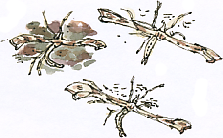previous | home page | this month | e-
Plume Moth
Richard Bell’s Wild West Yorkshire nature diary, Thursday, 2nd July 2009

LIKE A FLYING bow tie or coathanger, this feathery winged micro-
There’s a small V-
The caterpillars of the Triangle Plume Moth, Platyptilia gonodactyla, feed on coltsfoot.
They make use of every part of the plant: at this time of year they feed on the leaves,
in the winter they hibernate in the stems, emerging in the spring to feed on the
flowers before pupating in the fluffy seed-
Butterbur is an alternative food plant.
previous | home page | this month| e-